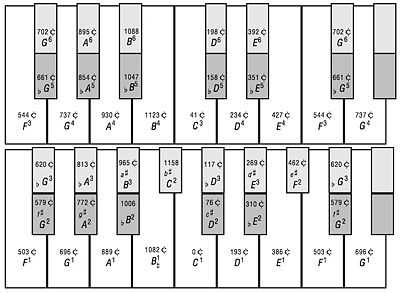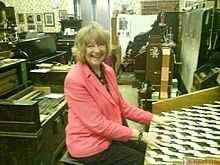Enharmonic keyboard
An enharmonic keyboard is a musical keyboard, where enharmonically equivalent notes do not have identical pitches. A conventional keyboard has, for instance, only one key and pitch for C sharp and D flat, but an enharmonic keyboard would have two different keys and pitches for these notes. Traditionally, such keyboards use black split keys to express both notes,[1][2] but diatonic white keys may also be split.[3]
As important device to compose, play and study enharmonic music,[4] enharmonic keyboard may produce microtones and have separate keys for at least some pairs of not equal pitches that must be enharmonically equal in conventional keyboard instruments.[5]
The term (divergence of scholar opinions)
'Enharmonic keyboard' is a term used by scholars in their studies of enharmonic keyboard instruments (organ, harpsichord, piano,[6] harmonium and synthesizer) with reference to a keyboard with more than 12 keys per octave. Scholarly consensus about the term's precise definition currently has not been established.[citation needed]
In the New Grove Dictionary (2001) Nicolas Meeùs defines "enharmonic keyboard" as "a keyboard with more than 12 keys and sounding more than 12 different pitches in the octave".[7] He however does not specify the origin of the term in his article. Rudolph Rasch (2002) suggested to apply the term "enharmonic keyboard" more closely to keyboards with 29-31 keys per octave.[8]
Patrizio Barbieri (2007), in his turn, raised objection that this usage is not supported by early theoretical works.[9] As for historical evidence, confusion has often reigned over the terminology of split-keyed instruments, which were called sometimes 'chromatic', sometimes 'enharmonic'. The builders (or persons who only projected the construction) of such keyboard instruments often gave them names without any reference to genus, like 'archicembalo' (Nicola Vicentino), 'cembalo pentarmonico' (Giovanni Battista Doni), 'Clavicymbalum universale' (Michael Praetorius) or even simply 'Clauocembalo' (that is clavicembalo; Gioseffo Zarlino[10][11]).
Some modern scholars (Christopher Stembridge, Denzil Wraight) describe instruments with such keyboards as "split-keyed instruments".[12]
Known realizations






One of the first instruments with an enharmonic keyboard was the archicembalo built by Nicola Vicentino, an Italian Renaissance composer and music theorist. The archicembalo had 36 keys per octave and was very well suited for meantone temperament.[13] Vicentino also had made one arciorgano in Rome and one arciorgano in Milan. Both pipe organs was equipped with enharmonic keyboards, like those of the archicembalo.[14] None of Vicentino's instruments survive.
Many instruments with enharmonic keyboards were built during the Renaissance and Baroque eras. Most composers and performers who used these instruments are virtually unknown today. Among them are Johann Kaspar Kerll's teacher, Giovanni Valentini, who played a harpsichord with 77 keys for 4 octaves (19 keys per octave plus one extra C), and Friedrich Suppig,[15] published one of the definitive works for an instrument with an enharmonic keyboard: the Fantasia of the Labyrinthus Musicus, which is a multi-sectional composition that makes use of all 24 keys and is intended for a keyboard with 31 notes per octave and pure major thirds.
With the advent of microtonal music in the 20th century, instruments with enharmonic keyboards became more fashionable, as did early and Baroque music for such instruments. For performance and recording purposes, either old instruments are reconstructed or two recordings of two differently tuned instruments are combined in one, thus creating an effect of an enharmonic keyboard.
Isomorphic note-layouts are a class of enharmonic keyboard, opened in 1721 by Ivo Salzinger's Tastatura nova perfecta, Germany.[16] One isomorphic note-layout, the Wicki, when mapped to a hexagonal array of buttons, is particularly well-suited to the control of enharmonic scales. The orientation of its hexagonal columns of octaves and tempered perfect fifths place all the notes of every well-formed scale -- pentatonic (cardinality 5), diatonic (cardinality 7), chromatic (cardinality 12), and enharmonic (cardinality 19) -- in a tight, contiguous cluster.
The notes of each progressively-higher cardinality are appended to the outer edges of the lower-cardinality scale, such that each well-formed scale's note-controlling buttons are embedded, unchanged, within the set of those controlling the higher-cardinality scales. Hence, the skills gained in learning to play chromatic music on a chromatic Wicki keyboard can be applied, without modification, to performance on an enharmonic Wicki keyboard.
Isomorphic keyboards were not discovered until the latter half of the 19th century.[citation needed]
See also
- equal temperament
- meantone temperament
- musical tuning
- Janko keyboard
Notes
- ↑ Jerkert 2010, p. 121: "The concept of enharmonicity arises from the fact that certain tone pairs seem to refer to almost identical pitches . For example, from a given C we <...> will find that the pitches of C♯ and D♭ are close to each other (exactly how close will depend on the methods we allow for finding them). C♯ and D♭ are obviously not identical, but they are close enough to be treated as identical in certain musical settings. Therefore, they are enharmonically equivalent. An enharmonic instrument is an instrument where multiple ways of producing enharmonically equivalent tones are available. For example, an enharmonic keyboard could have separate keys for C♯ and D♭, as well as for each tone in other enharmonic pairs such as D♯/E♭, F♯/G♭, G♯/A♭ and A♯/B♭. An enharmonic keyboard is thus guaranteed to have more than 12 keys per octave"
- ↑ Rasch 2009, p. 61: "Enharmonic instruments should be understood as musical instruments presenting a number of pitches per octave that significantly surpasses the twelve notes of the standard western tuning systems (equal temperament, meantone tuning or whatever). This begins with harpsichords or organs with a few split upper keys, goes to keyboards with 17, 19, 31 or 43 notes per octave and ends with theoretical systems and ideas for instruments (less often the instruments themselves) up to far over 100 pitches per octave"
- ↑ Jerkert 2010, p. 121: "Note, however, that the extra keys need not be found among the sharps and flats. On p. 20 in Barbieri's book, for example, an organ from the end of the 1400's is depicted with no extra black keys but with two E keys, one suitable for use in an E major chord, and another better fitted as the third in a C major chord"
- ↑ Rasch 2009, p. 61: "Enharmonic music is music <...> that is mostly to be found in the surroundings of enharmonic instruments. Without those instruments nearby, it makes little sense to produce such music"
- ↑ HDM 2003, p. 295
- ↑ Tukhmanova 2005, pp. 23-6
- ↑ Meeùs, Nicolas, 2001. "Enharmonic keyboard", The New Grove Dictionary of Music and Musicians, edited by Stanley Sadie and John Tyrrell, accessed Oct. 12, 2012.
- ↑ Rasch 2002, p. ?
- ↑ Barbieri, Patrizio. Pietro della Valle: the Esthèr oratorio (1639) and other experiments in the “stylus metabolicus” (with new documents on triharmonic instruments). In: Recercare XIX/1-2 2007. The only theoretical evidence that agrees with Rasch's usage is found in one (not yet published) manuscript by some Benedetto Bresciani, written ca. 1719.
- ↑ Le istitutioni harmoniche, 1558
- ↑ Burundukovskaya 2008, p. 185: "In 1548 Dominicus Pizaurensis has built harpsichord with 19 divisions of the octave by the order and description of G. Zarlino <...> the earliest enarmonic instrument <...> manufacture date of which is known exactly (Russian: В 1548 году Доминикус Пизауренсис построил клавесин с 19 делениями в октаве по заказу и описанию Дж. Царлино <...> самый ранний энармонический инструмент <...> дата изготовления которого известна точно)"
- ↑ C. Stembridge: ‘Music for the Cimbalo Cromatico and Other Split-Keyed Instruments in Seventeenth-Century Italy', Performance Practice Review, v/1 (1992), 5–43; C. Stembridge: ‘The Cimbalo Cromatico and Other Italian Keyboard Instruments with Nineteen or More Divisions to the Octave (Surviving Specimens and Documentary Evidence)', Performance Practice Review, vi/1 (1993), 33–59; D. Wraight and C. Stembridge: ‘Italian Split-Keyed Instruments with Fewer than Nineteen Divisions to the Octave', Performance Practice Review, vii/2 (1994), 150–81.
- ↑ The best description of archicembalo along with recordings using the rebuilt instrument can be found in the book: Cordes, Manfred (2007). Nicola Vicentions Enharmonik. Musik mit 31 Töne. Graz: Akademische Druck- und Verlagsanstalt. ISBN 978-3-201-01884-5. There are many other descriptions of archicembalo given by modern scholars, e.g. in Christopher Stembridge's ‘The Cimbalo Cromatico and Other Italian Keyboard Instruments with Nineteen or More Divisions to the Octave (Surviving Specimens and Documentary Evidence)' // Performance Practice Review, vi/1 (1993), p.54 ff.
- ↑ Barbieri 2008, pp. 309-313
- ↑ Suppig 1722, pp. ?
- ↑ Barbieri 2008, pp. 337-341
References
- Barbieri, Patrizio (2007). "Pietro della Valle: the Esthèr oratorio (1639) and other experiments in the "stylus metabolicus". With new documents on triharmonic instruments" (ISBN 978-88-7096-526-1 255 pages). In Morelli, Arnaldo. Recercare. Rivista per lo studio e la pratica della musica antica (Lucca: LIM Editrice srl) XIX (1-2): 96–7. ISSN 1120-5741.
- Barbieri, Patrizio (2008). Enharmonic instruments and music 1470-1900. Latina, Italy: Il Levante Libreria Editrice. pp. 309–313. ISBN 978-88-95203-14-0.
- Burundukovskaya, E. (2008). "Italian Harpsichord and Clavichord 16th and 17th Centuries. Enarmonic instruments". In Zagidullina, M. V. Bulletin of the Chelyabinsk State University. 20 (in Russian) (Russia: Chelyabinsk State University) 121 (22 Philology and art history): 181–7. ISSN 1994-2796.
- HDM, Enharmonic (2003). Randel, Don Michael, ed. ♯v=onepage&q=Enharmonic%20Keyboard&f=false The Harvard Dictionary of Music (Fourth ed.). USA: Harvard University Press. p. 295. ISBN 0-674-01163-5.
- Jerkert, Jesper (2010). "Review of Patrizio Barbieri's Enharmonic Instruments and Music 1470–1900". Svensk Tidskrift för Musikforskning (Swedish Journal of Musicology) 92: 121. ISSN 1653-9672.
- Meeùs, Nicolas (2001). Sadie, Stanley; Tyrrell, John, ed. Enharmonic keyboard. The New Grove Dictionary of Music and Musicians accessed Oct. 12, 2012. ?: ?, vol. ?. p. ?.
- Rash, Rudolf (2002). "On terminology for diatonic, chromatic, and enharmonic keyboards" (ISBN 978-3-03910-088-0 br. (Softcover)). In Willimann, Joseph. Chromatic and Enharmonic Music and Musical Instruments in the 16th and 17th centuries. Schweizer Jahrbuch für Musikwissenschaft (Bern, Berlin, Bruxelles, Frankfurt/M., New York, Oxford, Wien, 2003: Peter Lang Publishing Group) 22: 21–33. ISSN 0259-3165.
- Rasch, Rudolf (2009). "Review of Patrizio Barbieri: Enharmonic Instruments and Music 1470-1900". In Gilmore, Bob. Thirty-One. The Journal of the Huygens-Fokker Foundation (Amsterdam: Stichting Huygens-Fokker Centre for Microtonal Music) 1: 61.
- Suppig, Friedrich (1722). Rasch, Rudolf, ed. Labyrinthus musicus; Calculus musicus: facsimile of the manuscript (190 p. 21 cm). Utrecht: Tuning and temperament library, vol. 3. Diapason Press, 1990. ISBN 9070907178.
- Tukhmanova, Z. (2005). "Enharmonic piano of prince V. F. Odoevsky". In Bocharov, Yu. S. Early Music. 3-4 (in Russian) (Moscow, Russia: Literary Agency PREST). 29-30: 23–6. ISSN 1999-6810.
Further reading
- Allen, John S. "The general keyboard in the age of MIDI".
- Khramov, Mykhaylo (December 2011). "On Amount of Notes in Octave". In Datta, Asoke Kumar; Sengupta, Ranjan. Ninãd, Journal of the ITC-SRA (Kolkata, India: ITC Sangeet Research Academy. Dept. of Academic Research) 25: 31–7. ISSN 0973-3787.
- Owen, Barbara (2006). Bush, Douglas; Kassel, Richard, ed. Enharmonic Organ. The Organ: An Encyclopedia. NY, USA. pp. 183–4. ISBN 0-415-94174-1.
| ||||||||||||||||||||||||||||||
| ||||||||||||||||

